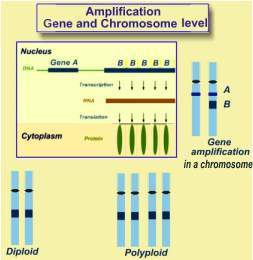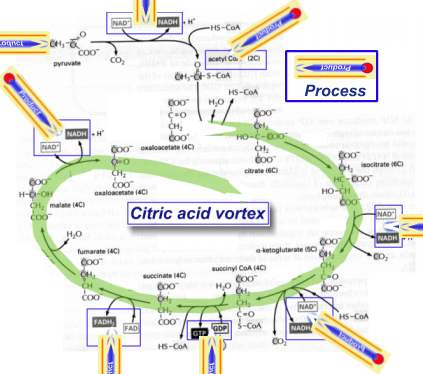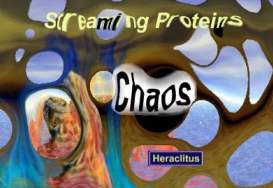 |
Each gene in the genome stores directives for the synthesis of one protein . It is located at origin of an assembly line along which the molecule is build. Its building blocks are amino acids. The genetic code stores information on amino acids that will be included in a protein. It is transcribed into a messenger RNA molecule, that directs other RNA types during protein assembly. Initially amino acids are linked together into a short peptide, that elongates by polymerization, then folds and twists into a mature protein. Eventually it disintegrates (dies), and its building blocks, the amino acids, are either re-utilized or eliminated in the urine.
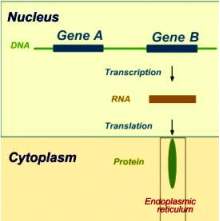 |
All along the entire process growing molecule
streams through a channel in the endoplasmic reticulum It
polymerizes as it streams, like the protein called collagen, that is depicted
herewith. It is produced by a connective tissue cell, the fibroblast. Code
for its assembly is stored in a gene. After it has been transcribed, and translated
into a peptide, it gradually elongates while streaming, turning into
an alpha-chain. Three alpha-chains joined together form a triple-helix that
continues streaming, through Golgi region where it is packed into secretory
vesicles. When leaving the cell it turns into tropocollagen that gradually
matures into collagen.
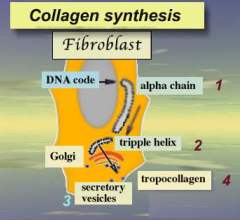 |
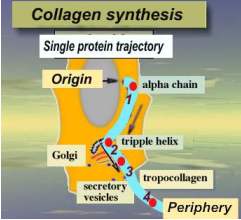 |
Protein matures as it streams
Channel walls, are covered with enzymes that add different molecules to the elongating chain, until it becomes a mature collagen. Each assembly channel can be represented by a trajectory that extends from origin to periphery, It is an instantaneous representation of collagen history. When young, it is called alpha-chain, as it grows older it turns into a triple-helix, and so on. We may read off molecular age from its position on the protein trajectory. Obviously a molecule at position-1 is younger than that at position-2. In this representation, age is proportional to molecular distance from origin.
Physical (chronological) and biological timeWe may distinguish between two kinds of age estimates, physical (or chronological), and biological. The first expresses protein aging in time units, like seconds or minutes, the second, in space units. Let’s take distance as measure of biological age. Space units will serve for event description in the same way as time units are applied in physics. Position-1 and –2 are respectively, 1.0 and 2.5 microns away from the gene at origin, Expressed as biological age, a molecule at position-1 is 1.0 micron old, and the age of a molecule at position-2 is 2.5 microns. The second molecule is 1.5 microns older that the first. This time measure is equivalent to chronological time, since when ordering molecules by their ages, we get the same age sequence. Their age distributions are identical.
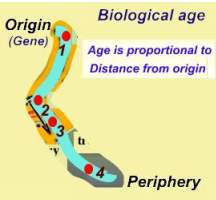 |
Rates may be expressed in space units
in the same way as done with time units. Suppose that molecular weights
of alpha-chain and a triple helix are respectively 1000 and 3000 dalton .
The rate of molecular growth is 2000 daltons/1.5 microns. While rates expressed
in physical time, require two measurements, like now and in a minute,
biological rates are read off the protein trajectory. The equivalence
between the two time measures stems from the fact that both times
are oriented. They flow in one direction, into the future. While future of
physical time is unknown, in biological time it may be observed. The future
of a protein ends at its periphery where it dies (Catabolism).
 |
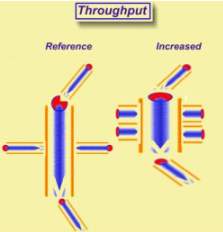 |
Protein trajectory has similar properties like tissue unit. An origin, periphery and a trajectory along which molecules stream while differentiating. Molecules like cells are formed at one site and stream to their graveyards. Lets define as process an oriented trajectory in space, with an origin and periphery. Velocity of its elements is controlled by the demand for its product by other processes. As demand rises, protein throughput increases it matures faster, and its trajectory shortens. It gets closer to cell membrane, releasing its product faster. Now, ages of alpha chain and triple-helix would respectively be, 0.5 and 1.0 microns, and the rate of molecular growth 2000 dalton/1.0 micron
Trajectory shortening was possible since assembly enzymes arrived at their locations on channel walls faster and increased their throughputs. Each enzyme is a process that originates in a gene. Thus, trajectory length depends on the context in which a process operates, e.g., demand for its product by other units, and performance of processes that support it. These make biological time, that operates in a process, non-linear . While physical time is linear, and one dimensional, biological time is two dimensional, and non linear. First dimension, distance, is linear. Second dimension, is the context in which a process operates, and is non-linear. Since biological time depends on both dimensions, it is relative. Even more relative than in Einstein’s space-time, since being chaotic.
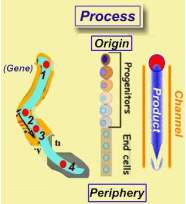 |
Time is a metaphor
Unlike physical time that extends from now to infinity, biological time is finite and created when a process is born. Both do not exist in nature. They are metaphors that help us to understand nature. Just like gravity or WOB. We take gravity for granted even if failing to understand how it pulls us down. In the same way we take WOB for granted even if we fail to understand how it keeps us healthy. Biological time may appear chaotic to us yet is meaningful to WOB. Treatment generally interferes with processes, and since only WOB knows how to optimize them, treatment has to be in accord with WOB’s “understanding”. Mathematically this would mean. At any instant, processes in the organism occupy a strange attractor. When WOB drives processes to a new attractor, it selects a path that improves health (tolerance). Correct treatment ought to follow the same path.
One may ask why do we need biological time
if it is chaotic? Since measuring events with physical time is even less effective.
Physical time requires that a process be somewhat isolated, interacting with
its context in a linear fashion, and change linearly with time. These requirements
are met only by machines. Processes in the living organism are massively
connected, operate in parallel , and in a non linear fashion.
Optimization
Car designers are concerned with features, like. engine power, efficiency,
safety, and reliability. The context in which a car operates, like road and
other cruising cars, is ignored. Roads and their content, change in
a linear fashion, and so does traffic. Suppose that a car maker is asked to
design a car that will change its size depending on road congestion.
When road is congested it would shrink, and sneak through traffic
as motorcycles do. If only one car with this feature, would be allowed
on the road, car maker might succeed to design an optimal car. But if
allowing other “shrinking cars” on the road, he might fail
During congestion all might shrink, yet none would sneak through.
Eager car makers would apply a massively parallel computer, like Connection
Machine to help them out. Yet even this super computer can not solve such
a problem. A massively parallel non-linear computer, might succeed,
yet this does not exist. In the living world such a computer controls
processes in our body and is called WOB . It knows how to optimize
any process set, otherwise we would not survive. So why bother optimizing
biological processes if WOB does it better than us. Let it “compute”
and we wait for its output.
In other words, let’s interrogate the WOB, and talk to it in its own
language . WOB’s messages involve biological time.
The Goal
What ought Medicine to look for when studying a process? Velocity? Efficiency
? Throughput? This question is discussed by Eliyahu M. Goldratt in his
best seller, “The Goal” (North River Press Inc. 1992 ISBN 0-88427-061-0).
How to manage a factory with interacting assembly lines, operating in parallel?
By a process of ongoing improvement. In order to improve you have first
to define your goal. Is it: Inventory, manpower, cost effective purchasing
, productivity, throughput, etc? "Not at all" says Jonah, a scientist
who studies manufacturing organizations."They are not the goals themselves;
they are just means of achieving the goal. The goal is making
money" . . " The key question is what is the minimum number
of measurements in order to know if the factory makes money"
Before approaching a patient we ought first
ask our self what is our goal? To cure him? To improve the quality of
his life? To make him happy? The answer ought to be: To make him healthier!
This ought to be our goal. Measurements made on our patient ought to
answer whether we do indeed make him healthier. Since WOB maintains patient's
health, our measurements ought to indicate whether our treatment improves,
or at least, maintains health.
Health of a biological process
It is not enough to realize that a process operates optimally. As physicians
we ought to be concerned with its capacity to withstand threat, or tolerate
hazard. We challenge a process by changing its context,
and observe how it reacts. Particularly whether it survives the perturbation.
The greater the challenge that it survives, the healthier is the process.
In this context tolerance is equal to health
. Obviously we could not apply this approach
to a patient. Yet we might watch how he reacts to perturbations initiated
by disease.
Before the advent of modern medicine physicians applied rules of thumb to
estimate patient's prognosis, like the behavior of fever. If steady,
the patient copes with disease, while an oscillating fever proclaims death.
At each instant WOB maintaines processes balanced, which called steady
state, or homeo-stasis. In the world of process
it ought to be renamed as steady stream, or homeo-rhesis. Patient health may be estimated by observing how
WOB maintains homeo-rhesis.
The same reasoning is applied to microscopic processes, observed in tissues.
Here health can be estimated from age distribution of elements along process
trajectory.
Summary:
Physical time:
- Extends from now to infinity.
- One dimensional and linear.
